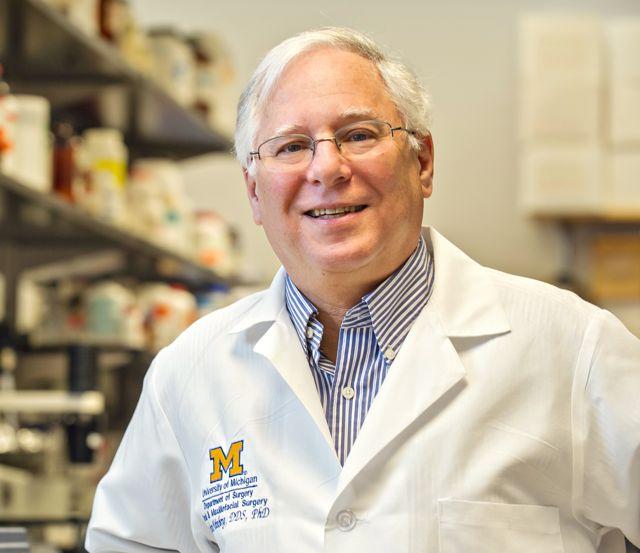Using a Patient’s Own Cells to Re-Grow Damaged Tissues4 min read
Ann Arbor, MI — March 11, 2013 — It’s an idea that, if successful, could benefit many, including war veterans who have sustained battlefield injuries and, ultimately, children and adults with developmental or acquired facial defects from trauma or disfiguring cancer surgery.

Dr. Stephen Feinberg, a professor of dentistry in the Department of Oral and Maxillofacial Surgery and Hospital Dentistry at the University of Michigan School of Dentistry, has been working with other U-M researchers to develop techniques that use a patient’s own oral “soft” tissue lining cells (keratinocytes) to reconstruct oral mucosa (soft tissues in the mouth).
Why rebuild oral mucosa? Two reasons. First, facial battlefield injuries; second, limited supplies of oral tissue.
Injuries to the jaw and upper face are common battlefield injuries that have been sustained by soldiers in Iraq and Afghanistan, Feinberg said. “One of the main problems with reconstructive procedures of the mouth following trauma is the failure to achieve satisfactory esthetic and functional results,” he said.
Ideally, oral mucosal-type tissue would be used in the reconstruction process. However, “oral tissue supplies are limited. When these tissues are needed to repair destructive injuries, there’s not much of it available,” Feinberg said. When a surgeon has to rebuild a large mouth wound, they have to use a skin patch from the side of a person’s leg to cover that wound. But using that type of skin tissue poses problems because it does not look like or act like real oral tissue, nor does it prevent bacterial infections within the mouth.
A Soft Tissue Equivalent
With funding from the National Institutes of Health, Feinberg has fabricated an alternative — a tissue-engineered human oral mucosa equivalent. The engineered soft tissue equivalent, developed from that research, is currently being used in several clinical reconstructive studies funded by the U.S. Department of Defense.
In addition, Feinberg and colleagues at the U-M Medical School are also attempting to fabricate more complex soft tissue structures, such as human lips, which are difficult to reconstruct after an avulsion injury (a forcible tearing or separation of one body part from another) because they include a composite of mucosa, skin, and muscles.
Significant loss of lip tissue is both a functional and esthetic concern because the neuromuscular control of normal lip structures is used in eating, drinking, talking, and facial gestures. Lip avulsion is survivable “but without functional lip reconstruction injured individuals are burdened for life with drooling, spilling their food while eating, unintelligible speech, and social rejection,” Feinberg said. When more than half of the lips are avulsed, facial transplantation and the consequences of a lifetime of immunosuppression therapy must be considered. The benefit of using a patient’s own cells, he added, is that lifelong immunosuppression therapy to prevent rejection would not be needed.
Feinberg is also expanding this approach to tissue engineering to other parts of the body that contain mucosa such as the eyelids, nose, and ears. “All of the work we have done with mucosa, along with the clinical trials, will be a steppingstone to fabricate more complex tissues,” he said.
Hard Tissue Reconstruction
In addition to his soft tissue research, Feinberg is also working on techniques to reconstruct hard tissues, such as facial bones and bones in the spine, by fabricating biodegradable scaffolds. A biodegradable polyester polymer (polycaprolactone) is formed as a mesh and coated with growth factors that stimulate a patient’s bone growth. As the bone grows, voids in broken bones are filled and the polymer dissolves.
Feinberg and four colleagues at the U-M North Campus Research Center have launched Tissue Regeneration Systems, a start-up company that hopes to commercialize this hard tissue reconstruction technology. TRS has received $2.25 million in a second round of venture capital funding, including $500,000 from the Pure Michigan Venture Match Fund to make the transition from being a start-up company to an actual manufacturer.
